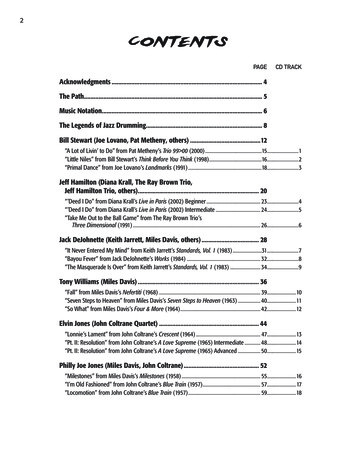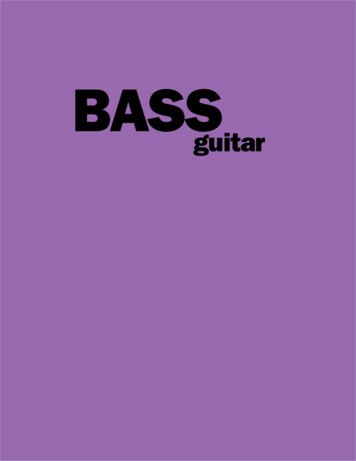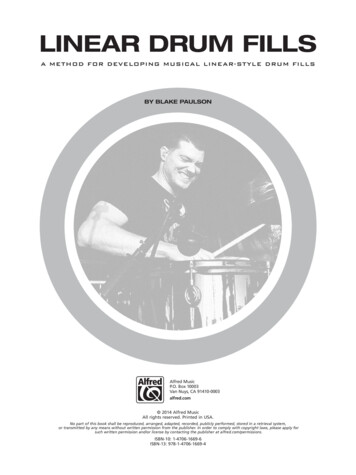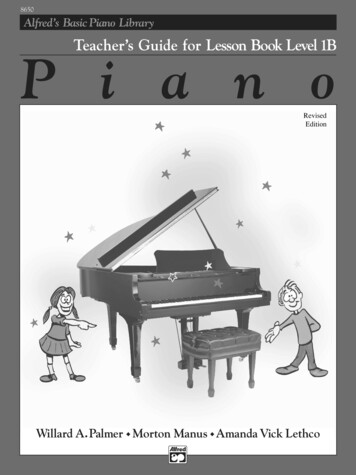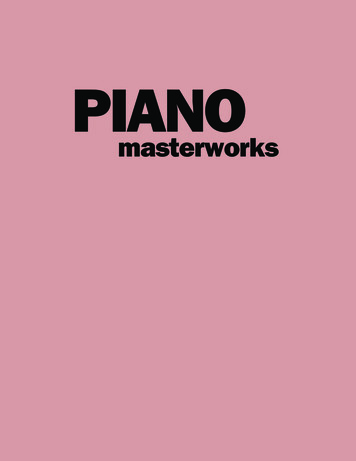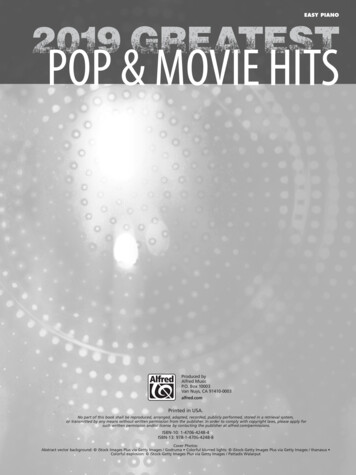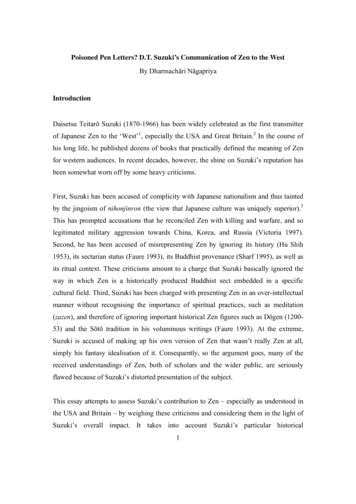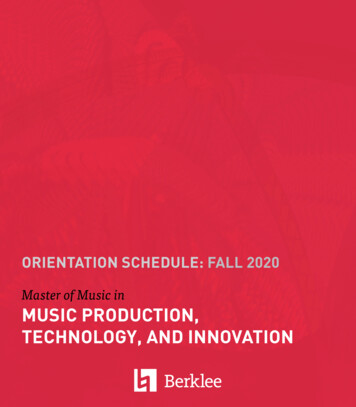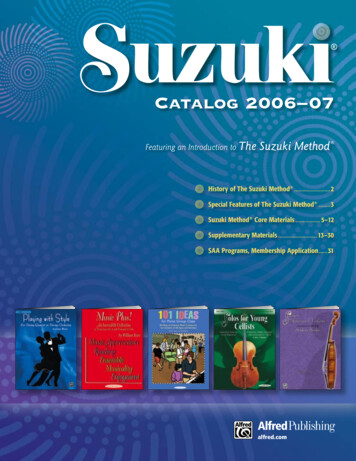
Transcription
Catalog 2006–07Featuring an Introduction to TheSuzuki Method History of The Suzuki Method .2Special Features of The Suzuki Method .3Suzuki Method Core Materials . 5–12Supplementary Materials .13–30SAA Programs, Membership Application .31alfred.com
SHINICHI SUZUKIOctober 17, 1898–January 26, 1998History of The Suzuki Method One Man’s VisionShinichi Suzuki—violinist, educator, philosopher, andhumanitarian, was born in 1898, the son of Japan’s firstviolin manufacturer. Suzuki worked in the violin factory asa child, but was not interested in playing the violin until hewas seventeen. Suzuki then studied violin in Japan for someyears before going to Germany in the 1920s for further study.When he returned to Japan, Suzuki and his brothers formeda string quartet that toured extensively. He also taught violinat universities in Tokyo and elsewhere. During this period,Suzuki became interested in the education of young children.BeginningsThere are moments in history when a place, atime, a man and an idea converge to produceresults of great significance. Such a momentoccurred when Shinichi Suzuki began hisexperiments in violin teaching in Japan. Theresults have attracted widespread attention, andhave generated much speculation about the natureof musical learning and the way in which everyhuman being develops in the early formativeyears. It is not that any particular segment ofSuzuki’s ideas is new, but rather that the totalityof his concepts, together with the results he hasshown, throw a clear light on a question we wish toexplore—how do human beings become musical?The Suzuki Violin Method inAmerican Music EducationAfter World War II, Suzuki carried his interest andsympathy for children into his work as a musician andteacher. Encouraged by the ability of children to assimilatetheir mother tongue, he saw a great opportunity to enrichtheir lives through music. He based his approach on thebelief that musical ability is not an inborn talent, but anability that can be developed—that the potential of everychild can grow if the child is given the proper trainingand learning environment. Noting that children the worldover learn to speak their native language with ease, Suzukiapplied the basic principles of language acquisition to thelearning of music. He called his method the mother-tongueapproach, or Talent Education.In 1945, Suzuki was invited to teach at a school inMatsumoto. He accepted with the condition that he couldtry this new method he had developed to teach very youngchildren. Because he was a violinist, he applied his theoriesfirst in teaching them to play the violin. (Today the Methodincludes piano, violin, viola, cello and bass, flute, harp,guitar, recorder, and organ.)Within a year after beginning his program, Suzuki presentedsome of his young students at a concert in Tokyo. Listenerswere amazed at the performance of the children, and theTalent Education movementbegan to grow.— John KendallInstead of ignoring the early years,it is our duty to cultivate themwith the utmost care.— Alexis Carrel2
It may very wellbe music whichwill save the world.—Pablo CasalsDevelopment of the MethodOver the next 30 years, Suzuki did extensive research todevelop his series of violin repertoire books. He chose his piecescarefully, so they would present musical and technical pointsin a logical, sequential manner. Other violin teachers studiedwith Suzuki and began to teach throughout Japan. The TalentEducation program expanded to include other instruments,and materials were designed and published for piano, cello,and flute. Thousands of children received Suzuki training at theTalent Education Institute in Matsumoto or one of the branchschools in other Japanese cities.Introduction to the United StatesSuzuki’s Talent Education was introduced in the U.S. whena film of the first National Graduation Concert in Japan wasshown at Oberlin College in 1958. Since then, teachers frommany countries have visited Japan to learn more about Suzukiand his work. Suzuki’s tour group of ten Japanese childrencame to the United States for the first time in 1964. Since then,tour groups of Japanese children have performed annually foraudiences all over the world.Suzuki Method TodaySuzuki’s idea of teaching peace and understanding throughmusic gradually gained acceptance. His active leadershipfor more than fifty years until his death in January of 1998brought thousands of parents and teachers in at least fortycountries in Asia, Europe, Australia, Africa, and the Americasto join his effort to nurture loving human beings through themother-tongue approach to music education. Thousands ofchildren throughout the world are now able to gather and playtogether, overcoming linguistic and cultural barriers throughthe language of music. The dream of Dr. Shinichi Suzuki iscoming true.Special Features of The Suzuki Method An Early Beginning.Talent Education usually begins at an early age. Suzukisuggested that parents repeatedly play recordings of classicalmusic for their infants and toddlers. Formal training oftenbegins at age three or four, but it is never too late to begin TheSuzuki Method .Parent Involvement.As when a child learns to talk, Suzuki parents are involvedin the musical learning of their child. Parents work with theteacher to create an enjoyable learning environment, especiallyat home, so that much of the child’s motivation comes fromenthusiasm for learning and the desire to please. Parents attendlessons with their child and serve as “home teachers” during theweek. They supervise practicing, making sure the student doesexactly as the teacher instructed. Sometimes, one parent learnsto play before the child, so the parent understands what thechild is expected to do.Younger students, whose attention spans are short, may haveseveral brief practices each day, instead of one long practice.The parent encourages the child, giving praise for each effort,so practice time is a positive experience. The length of practicetime gradually increases as the student advances through therepertoire. Parents need not be musicians. They are taughtstep by step how to help the child at home. Each child learnsat his or her own rate, building on small steps so each onecan be mastered. Teachers and parents meet the child’s effortswith sincere praise and encouragement. Children are alsoencouraged to support each other’s efforts, fostering an attitudeof generosity and cooperation.The Suzuki teacher actually serves as mentor to both the parentand child in their study of the instrument—teaching the childat the lesson and guiding the parent in developing effectivetechniques for teaching the child at home.Parents have a great responsibility as home teachers beyondattending lessons and assisting with practice at home. Their roleinvolves committing themselves to their own on-going educationabout the Suzuki approach, creating a musical environment,learning the fundamentals of playing the instrument andtaking care of it, and creating a total environment of affection,encouragement, and understanding. The most importantingredient for success is the parents’ willingness to devoteregular time to work closely with the child and the teacher.The Suzuki Method requires a three-way partnership betweenthe student, the teacher, and the parent—all working togethercombining a philosophy, a technique, and a program of education.3
Where there’s a will,there’s a way.— Bernard ShawListening and Observing.Children learn to speak by listening and imitating the languagespoken around them. By listening to recordings of the literaturethey will learn, as well as listening to other music, childrenabsorb the language of music just as they absorb the sounds oftheir mother tongue.Music reading is postponed until the child’s aural andinstrumental skills are well established, just as we teachchildren to read language only after they can speak. In thisway, the focus of the teacher’s and student’s attention can beon the development of good posture, beautiful tone, accurateintonation, and musical phrasing.Enriching Children’s Lives through Music.Children can learn a great deal from each other, so Suzukistudents are encouraged to observe the private lessons ofother students. They enjoy observing other children at alllevels—aspiring to the level of more advanced students, sharingchallenges with their peers, and appreciating the efforts of thosefollowing in their footsteps.The purpose of Suzuki training is to help every child find the joythat comes through music making. Through the mother-tongueapproach, children develop confidence, self-esteem, self-discipline,concentration, and the determination to try difficult things.In the environment of loving support fostered by The SuzukiMethod , children develop a lasting enjoyment of music.Repertoire.Dr. Suzuki’s primary goal was never just to teach young peoplehow to play musical instruments. Rather, he championed theunique contribution music can make in the total learningprocess. He believed that with the proper environment andeducational process and through the medium of music,sensitivity and understanding may be raised in children,creating for each child a better life—and for us all, a betterworld. Talent Education not only provides the child with anenriching musical experience, but also creates an atmosphereof sharing and mutual learning in which parent and child canbond in a unique and rewarding manner.All Suzuki students follow the same sequence of musical materialsfor their particular instrument, with each piece becoming abuilding block in the careful development of technique. Eachdiscipline—piano, violin, viola, cello, bass, flute, recorder,harp, guitar, organ—has its own repertoire. This standardizedrepertoire also provides strong motivation as younger studentswant to play music they hear older students play.Review is an important aspect of The Suzuki Method . Throughconstant repetition of pieces, children strengthen old skills andgain new ones. Students can hear for themselves the progressthey have made.Individual and Group Activities.In addition to their own individual lessons, students participate ingroup lessons, performances, and observation of other children’slessons—all activities that are valuable aids to motivation.Children learn from more advanced students and from theirpeers. Children love to do what they see other children do.Group lessons also provide frequent opportunities for childrento play solos in a relaxed, informal setting. Here each child mayshow what he or she has accomplished and has the opportunityto learn from the performances of other students. Parents areencouraged to schedule home recitals so both parents, not justthe one working daily with the child, can share in the child’sprogress and provide motivation to practice more. Frequentopportunities to play before an audience increase the student’sself-confidence, and that student enjoys, rather than fears,playing before others.4Reading.Although Dr. Suzuki has finished his earthly presence amongus, his spirit remains and is manifested daily in the myriadteachers and students who live his principles and his dream.Where love is deep,much willbe accomplished.All photographs are by Arthur Montzka. The Suzuki name, logo and wheel device are trademarks of Dr. Shinichi Suzuki and are usedunder exclusive license by Alfred Publishing Co., Inc. Copyright 2006, 2004, 2002, 2000, 1998, 1996, 1984 Dr. Shinichi Suzuki.Sole publisher for the entire world except Japan: Exclusive Print License administered by Alfred Publishing Co., Inc.—Shinichi Suzuki
Suzuki Method Core MaterialsPianoVolume 4 (00-0163S)Suzuki Piano SchoolPiano BooksVolume 1 (00-0473S) (Revised) . 6.95UPC: 654979003120Volume 2 (00-0474S) (Revised) . 6.95UPC: 654979013655Volume 3 (00-0162S) . 6.95UPC: 654979996965Volume 4 (00-0163S) . 6.95UPC: 654979998778Volume 5 (00-0442S) (Revised) . 6.95UPC: 654979003083Volume 6 (00-0443S) (Revised). 6.95 UPC: 654979003069Volume 7 (00-0444S) (Revised). 6.95 UPC: 654979008088Performed by William AideVolumes 1 & 2 (00-0461). 15.95Volumes 3 & 4 (00-0462) . 15.95Volume 5 (00-0463) . 15.95Volume 6 (00-0464) . 15.95Volume 7 (00-0465) . 15.95UPC: 029156150285UPC: 029156150292UPC: 029156150308UPC: 029156150315UPC: 029156150322Performed by KataokaVolume 1 (00-0497). 15.95 UPC: 029156150339Volume 2 (00-0498) . 15.95 UPC: 029156150346Volume 3 (00-0499) . 15.95 UPC: 029156150353Performed by Valery Lloyd-WattsVolumes 1 & 2 (00-0896) . 15.95Volumes 3 & 4 (00-0897) . 15.95Volume 5 (00-0898) . 15.95Volume 6 (00-0899) . 15.95Volume 7 (00-0900) . 15.95Volume 5 (Revised) (00-0442S)Contents are: Für Elise, Wo O59 (L. van Beethoven) Arabesque from 25 Easy and ProgressiveStudies, Op. 100, No. 2 (F. Burgmüller) By the Limpid Stream from 25 Easy and ProgressiveStudies, Op. 100, No. 7 (F. Burgmüller) Sonatina in F Major from Zwei Leichte Sonaten No.2, Kinsky-Halm, Anh. 5 (Allegro assai, Rondo: Allegro) (L. van Beethoven) Old French Songfrom Album for the Young, Op. 39, No. 16 (P.I. Tchaikovsky) Prelude in C Major from TheWell-Tempered Clavier, Vol. I
Suzuki worked in the violin factory as a child, but was not interested in playing the violin until he was seventeen. Suzuki then studied violin in Japan for some years before going to Germany in the 1920s for further study. When he returned to Japan, Suzuki and his brothers formed a string quartet that toured extensively. He also taught violin at universities in Tokyo and elsewhere. During .

